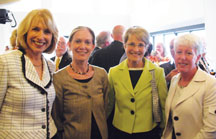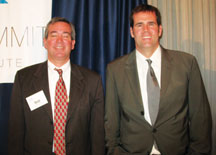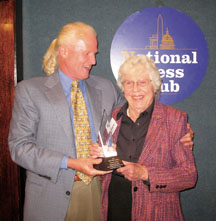Executive Editor
WASHINGTON , D.C.--Experts from across the country and throughout a variety of disciplines--including the ophthalmic community, low vision advocates, rehabilitation experts and low vision patient groups--gathered at the National Press Club here recently for The Vision Summit: Focus on Low Vision sponsored by the Better Vision Institute (BVI).
 |
| Presenters from the panel, the Current Landscape, are left to right Asel Ryskulova, MD, Centers for Disease Control and Prevention; Cynthia Stuen, PhD, senior vp policy and professional affairs, Lighthouse International, and Dan Roberts, founding director, MD Support & International Macular Degeneration Support Group. |
According to the BVI, 6.5 million Americans aged 65 and older suffer from low vision, and the number of Americans affected is expected to increase as the nation’s population ages. The general consensus among the speakers was that currently, low vision needs are not being adequately met and the aging Baby Boomer population will only exacerbate the need for expanded services and personnel specializing in low vision.
Paul Michelson, MD, Better Vision Institute liaison, opened the meeting by raising several key issues for attendees: “Our goal here is to find viable models for busy ECPs to use. They are under a tremendous amount of pressure to see many patients. How can they determine who needs treatment for low vision? Once that happens, can the treatment be handled in a private center or a rehab facility?”
The presentation was organized into four panels highlighting the following categories: the Current Landscape, the Patient Perspective, the Professional Perspective, and Economic Models of Care.
 |
|
Attending the dinner and reception the night before the meeting are left to right, Tara Cortes, PhD, president and CEO, Lighthouse International; Mary Lou Jackson, MD, chair, AAO Vision Rehabilitation Committee; Lylas Mogk, director, Visual Rehabilitation and Research Center, Henry Ford Health System, and Catherine Cohen, VP, Governmental Affairs, AAO. |
Treating the patient as a whole was a recurring theme throughout the day. During the second panel on patient perspectives, speakers currently living with low vision recounted their personal experiences and challenges. Mark F. Farrell is an on-air personality and talk show host for 1019 RXP FM--New York’s Rock Experience. He suffers from Retinoschisis, a congenital visual impairment, but his disability hasn’t stopped him from getting his driver’s license with the use of telescopic glasses. During his presentation, Farrell demonstrated the use of his special glasses and magnifiers, manufactured by Eschenback Optik of America. He joked that they made interesting conversation pieces if he is ever pulled over by the police. But on a more serious note, he advised patients with low vision to “be as proactive as possible. Don’t think about what you can’t do but what you can do.”
 |
| Presenters from the panel, The Patient Perspective, are Bill Robinson (l), CPA, and Mark Farrell, talk show host for 1019 RXP FM--New York’s Rock Experience. |
From the private sector perspective, Ronald J. Cole, MD, runs MVT Visual Rehabilitation Center in Sacramento, Calif. and his practice takes a multi-disciplinary approach to low vision. “We have 12 ophthalmologists in four offices in addition to a support staff of occupational therapists. Certain services, such as clinical psychology is outsourced but we work as a team,” Cole said.
 |
|
Geoffrey Moss, Eschenbach Optik of America presents Eleanor Faye, MD, medical director of Lighthouse International with the Visionary Award from the Better Vision Institute. |











